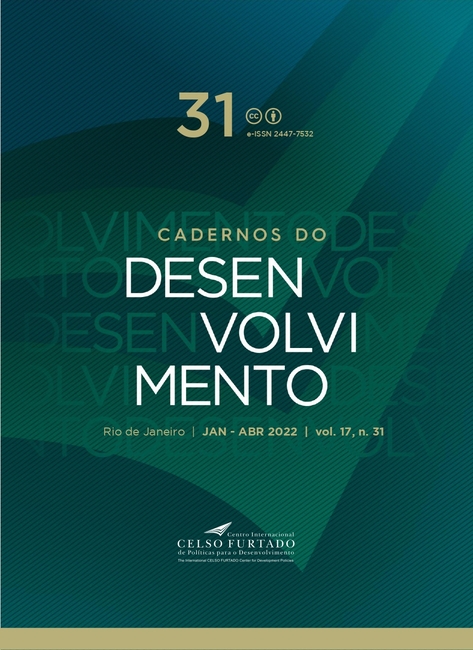Critical assessment of the mainstream interpretation of the end of the Golden Age of Western Capitalism
Keywords:
Golden Age, History of Economic Thought, Political Economy, MonetarismAbstract
This paper aims to present and critically analyze the mainstream interpretation of the end of the Golden Age of Western capitalism, a phase of high economic growth and low unemployment rates that followed the Second World War. In this sense, Milton Friedman's contribution, in the context of the rise of the liberal movement, is understood as being the main reference, both for the dominant interpretation of the stagflation of the 1970s and to support economic policies (which contributed to the macroeconomic performance) of subsequent decades. Thus, through literature review and analysis of descriptive statistics, the paper points to the political bias of the emergence of the monetarist theoretical framework, whose dominance both reflected and had a great impact on the conditions of the distributive conflict of the analyzed period.
Downloads
References
ABEL, A.; BERNANKE, B. Macroeconomics. Reading, MA: Addison-Wesley, 1998.
BARRO, R. J. E.; GORDON, D. Rules, Discretion and Reputation in a Model of Monetary Policy. Journal of Monetary Economics, n. 12, p. 101-121, 1983.
BARROS. L. A. “Grande Moderação” nos EUA: uma interpretação pós keynesiana. Instituto de Economia da UFRJ. Rio de Janeiro, 2018.
BARROS, L.; BASTIAN, E. F.; BASTOS, C. P. Inflação e desemprego nos Estados Unidos da América durante a Grande Moderação. Revista da Sociedade Brasileira de Economia Política, n. 55, jan.-abr. 2020.
COLANDER, D. et al. The changing face of mainstream economics. Review of Political Economy, v. 16, n. 4, p. 485-499, 2004.
DE LONG, J. B. America's peacetime inflation: the 1970s. Reducing inflation: Motivation and strategy. Chicago: Univ. of Chicago Press, 1997.
DEQUECH, D. Neoclassical, mainstream, orthodox, and heterodox economics. Journal of Post Keynesian Economics, v. 30, n. 20, p. 279-302, 2007.
FRIEDMAN, M. Comments on monetary policy. The Review of Economics and Statistics, v. 33, n. 3, p. 186-191, Aug. 1951.
FRIEDMAN, M. Inflationary Recession. Newsweek, n. 17, p. 92, Oct. 1966.
FRIEDMAN, M. The Role of Monetary Policy. The American Economic Review, v. 58, n. 1, p. 1-17, 1968.
FRIEDMAN, M. We Must Stand Firm against Inflation. Reader's Digest, p. 202–206, June 1970.
FRIEDMAN, M. Three Views of Nixonomics and Where It Leads. Newsweek, p. 74-75, 31 Jan. 1972.
FRIEDMAN, M. The Case for a Monetary Rule. Newsweek, p. 67, 7 Feb. 1972.
FRIEDMAN, M. Dealing with Discontent. Newsweek, n. 19, p. 69-70, Aug. 1974.
FRIEDMAN, M. Is Inflation a Curable Disease? University of Pittsburgh Graduate School of Business, Lecture, 5 December 1974.
FRIEDMAN, M. Inflation and Unemployment. Journal of Political Economy, n. 85, p. 451-472, 1976.
FRIEDMAN, M. Answering the Big Questions, by Milton Friedman and Paul A. Samuelson. Newsweek, n. 2, p. 80-81, May 1978.
FRIEDMAN, M. Capitalism and Freedom. London: Univ. of Chicago Press, 1982.
FRIEDMAN, M. Inflation: Retrospect and Prospect. Stanford Magazine, p. 38-40, Winter 1984.
FRIEDMAN, M. The Counter‐Revolution in Monetary Theory. Issues in Monetary Policy – “The Relationship between Money and the Financial Markets”, p. 171-183, 2012.
GOODFRIEND, M. How the World Achieved Consensus on Monetary Policy. Journal of Economic Perspectives, American Economic Association, v. 21, n. 4, p. 47-68, 2007.
GORDON, R. Price Inertia and Policy Ineffectiveness in the United States, 1890–1980. Journal of Political Economy, n. 90, p. 1087–1117, 1982.
GORDON, R. The History of the Phillips Curve: Consensus and Bifurcation. [S. l.]: Northwestern University; NBER; CEPR, 2011.
KYDLAND, F. E. E.; PRESCOTT, E. C. Rules Rather than Discretion: The Inconsistency of Optimal Plans. Journal of Political Economy, n. 85, p. 473-492, 1977.
MOORE, B. J. Horizontalists and verticalists: the macroeconomics of credit money. Cambridge: Cambridge Univ. Press, 1988.
NELSON, E.; NIKOLOV, K. UK Inflation in the 1970s and 1980s: the Role of Output Gap Mismeasurement. Journal of Economics and Business, v. 55, n. 4, p. 353-370, 2003.
NELSON, E. The Great Inflation of the Seventies: What Really Happened? B. E. Advances in Macroeconomics, n. 5, art. 3, 2005.
PALLEY, T. I. Milton Friedman and the monetarist counter-revolution: a re-appraisal. Eastern Economic Journal, v. 19, n. 1, p. 71-81, 1993.
PANITCH, L.; GINDIN, S. The making of global capitalism: the political economy of the American Empire. London; New York: Verso, 2012.
PHILLIPS-FEIN, Kim. Invisible hands: The making of the conservative movement from the New Deal to Reagan. Yayasan Obor Indonesia, 2009.
PIVETTI, M. An essay on the monetary theory of distribution. London: Macmillan, 1991.
ROMER, C. D.; ROMER, D. H. The Evolution of Economic Understanding and Postwar Stabilization Policy. Rethinking Stabilization Policy, Federal Reserve Bank of Kansas City, p. 11-78, 2002.
TAYLOR, J. B. The Great Inflation, the Great Disinflation, and Policies for Future Price Stability. In: BLUNDELL-WIGNALL, A. (Ed.). Inflation, Disinflation and Monetary Policy. Sydney: Ambassador Press, 1992.
TAYLOR, J. B. Discretion versus policy rules in practice. In: Carnegie-Rochester conference series on public policy. North-Holland: [S. n.], 1993.
TOBIN, J. et al. Stabilization policy ten years after. Brookings Papers on Economic Activity, v. 1980, n. 1, p. 19-89, 1980.
Downloads
Published
How to Cite
Issue
Section
License
Autores que publicam nesta revista concordam com os seguintes termos:- Autores mantém os direitos autorais e concedem à revista o direito de primeira publicação, com o trabalho simultaneamente licenciado sob a Licença Creative Commons Attribution que permite o compartilhamento do trabalho com reconhecimento da autoria e publicação inicial nesta revista;
- Autores têm autorização para assumir contratos adicionais separadamente, para distribuição não-exclusiva da versão do trabalho publicada nesta revista (ex.: publicar em repositório institucional ou como capítulo de livro), com reconhecimento de autoria e publicação inicial nesta revista;
- Autores têm permissão e são estimulados a publicar e distribuir seu trabalho online (ex.: em repositórios institucionais ou na sua página pessoal) a qualquer ponto antes ou durante o processo editorial, já que isso pode gerar alterações produtivas, bem como aumentar o impacto e a citação do trabalho publicado (Veja O Efeito do Acesso Livre).


